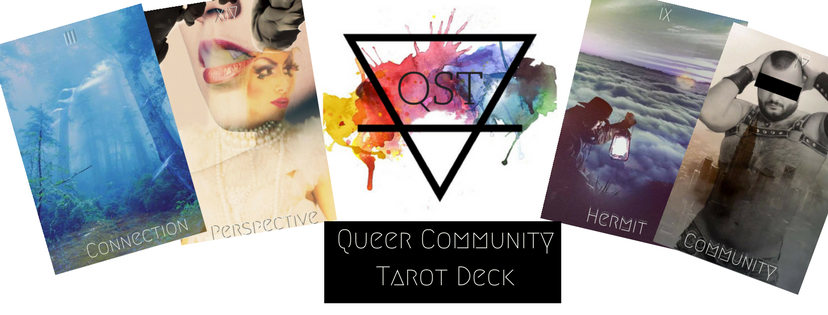Pagan Perspectives
Tarot is a popular divinatory system utilized by many Pagans and Witches of all stripes. With so many variations available to the public (and more being created all the time), we have an opportunity not just to work with an artistic style that we enjoy, but – thanks to the advent of decks engineered with specific communities in mind – we can also “fine tune” the symbolic language utilized by tarot and apply it in a way that speaks more directly to our own experiences and peoples. Enter The Queer Community Tarot.
The brainchild of J. Ryan of Queer Street Tarot, The Queer Community Tarot is set to be released this coming November. It intends to speak to LGBT+ practitioners using a common language. Any community will develop its own lexicon; a collection of words, stories, customs, and symbols held in common that convey the inner nature of what it means to be part of that culture. This deck draws from that lexicon in a colorful display of physicality, ethnicity, gender fluidity, and interracial themes, in the hopes that the queer reader will have an opportunity to see themselves depicted therein.
Even before we delve into the cards and their art, we are immediately confronted with the political nature of this project. “Queer” is a term that has long been a weapon used against sexual and gender minorities as an insult. In the late 1980s, however, LGBT+ activists began a campaign to reclaim the term, wearing it as a badge of pride. In 1990, one group, Queer Nation, anonymously circulated a flyer at the New York Gay Pride Parade entitled “Queers Read This,” explaining the thinking behind adopting the term “queer”:
Ah, do we really have to use that word? It’s trouble. Every gay person has his or her own take on it. For some it means strange and eccentric and kind of mysterious… And for others “queer” conjures up those awful memories of adolescent suffering… Well, yes, “gay” is great. It has its place. But when a lot of lesbians and gay men wake up in the morning we feel angry and disgusted, not gay. So we’ve chosen to call ourselves queer. Using “queer” is a way of reminding us how we are perceived by the rest of the world.
Even within the LGBT+ communities, the term “queer” is a point of sometimes much-heated debate. Using a term that confronts rather than soothes is an important reminder of how at least a sizable portion of the larger society views LGBT+ persons, lest we get complacent, relaxing into a sense of comfortable denial. When we hear a word that has been used as a weapon against us, we may find ourselves experiencing a knee-jerk reaction to hearing it. We can be shocked into an acute awareness of just how vulnerable we may be, as well as how uniquely beautiful. “Queer” reflects that uniqueness, that strange beauty. It is “not normal” by societal standards, a source of pain for some to be certain, but “queer” also can be the foundation of power and a viewpoint that differs from that of the mainstream. The queer person has a perspective that the average person does not.
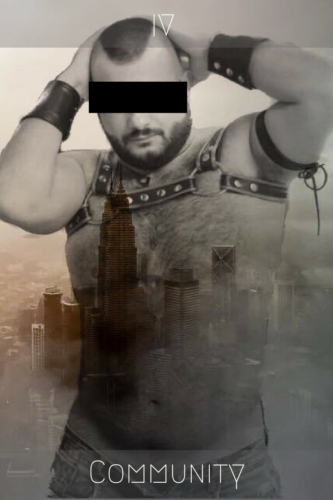
“Community,” the emperor card from the Divine Masculine deck [courtesy J. Ryan].
J. Ryan, the deck’s creator, has this to say about the community card:
The other meaning I found in it was that the community really demands that someone find themselves, through sheer truth. It’s a terrifying thing but the community that we are in wants us to own our power, to stand in it and that’s very much the emperor to me. We aren’t just given the throne, we have to fight the biggest enemy there is, the voice in our head that isn’t us entirely; but the voices of society who may not have our best interests at heart. Does that make sense? I suppose one could also talk about anonymous and casual hookup culture as well.
“Temperance” is here reborn as “perspective” and portrays a collage comprised primarily of two images: a face shot of a person with full drag-queen-level-flawless makeup, superimposed with a closeup of (presumably) said person’s lipstick-painted mouth, exhaling smoke in a sensual display. Supporting elements of the image add further mystery to the piece, which leaves one feeling as though they have seen a lot going on but are uncertain as to whether or not they have seen the full picture.
The card customarily titled “the chariot,” a card of choices and forward motion, is here named “rise” and depicts a woman’s profile overlaid with the image of a broom, evoking the essence of a witch riding across the cloud-filled sky.
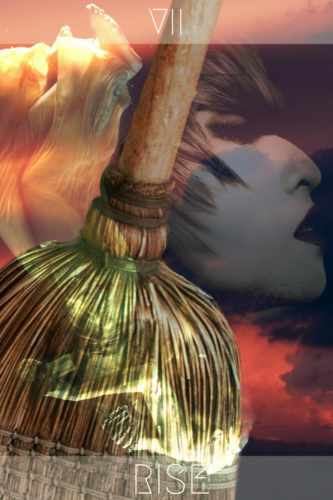
“Rise,” the chariot card from the Divine Feminine deck [courtesy J. Ryan].
Like many things with the “queer” label, The Queer Community Tarot draws inspiration from an appreciation for the physical body. While it might be easy for some to dismiss the use of homoerotic imagery as mere frivolity, even as stereotypical, it is thoughtful and deliberate – and necessary. The body as a vehicle for pleasure (and therefore political power) has been a driving force since the beginning of the LGBT+ movement, which, like feminism, stresses the inherent right to sex for pleasure against sex only for procreation. In this, The Queer Community Tarot draws (if perhaps unsurprisingly) from images of attractive, shirtless, gym-toned men.
One thing that I am pleased about is the presence of different ethnicities in the images. In the sampling of cards presented on the artist’s website, one can see card images including men from apparent Asian, African, Hispanic, and European descents, each expressing a different way to embody male beauty. In this, Ryan hopes to give people another means to see themselves represented in the world.
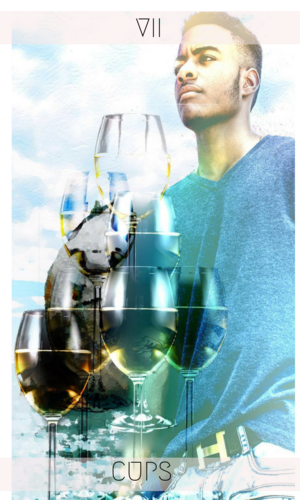
The seven of cups from the Divine Masculine deck [courtesy J. Ryan].
Community and feeling a sense of belonging were and are such incredibly important themes in many queer lives that it made sense to me that not every card would resonate with a person… [S]o I thought, how neat would it be if I had options? Ways to make connections with individual cards that reflect me and allow me to be proud of the deck I am using.
I see it on smaller scales with the Lovers card, typically. Some more progressive decks come with at least three to pick from. But the ability to swap out all cards until your deck is unique to you? We all have swirls and whorls on our fingers, but only you’ll have your exact setup. I think the customization is exactly why someone would want to create their own decks.
As for a particular message this deck might bring into the world, Ryan wants to spread the idea of one’s right to choose their own communities. “We do not have to become frozen in a crummy situation surrounded by people or things that make us feel less about ourselves,” Ryan says. “The tarot is a tool that shows us how to open a multitude of doors, kind of like the holiday trees in The Nightmare Before Christmas, but it’s our homework to walk through them and approach the lessons/next steps on the other side of those doors.”
Ryan goes on to point out the importance of being unashamed of one’s identity is also crucial to the deck:
Less obvious, I think, is that I like being different. I didn’t always. I was a quiet kid growing up, but somewhere down the line I threw that out. I’m a big guy. And I’m loud. A lot of people will give that the side eye these days, but I try to show them that I’m just me. My partner once said that he loved that I was so unapologetically gay. I love that. I think that I want this deck to help people be unapologetic for being their most amazing selves. If they’re happy, living their truth, and not harming anyone, then this deck will hopefully encourage them to continue shining in their own way.
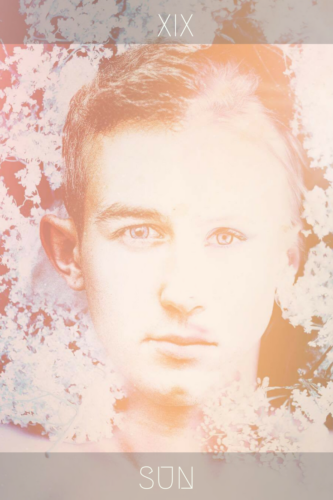
The sun card from the Divine Spirit deck [courtesy J. Ryan].
Ryan began working with the tarot about 15 years ago, while in middle school. Having survived his adolescent “let’s be goth to be edgy and make our parents mad” phase, he continued working with the cards, eventually offering readings professionally.
Decks may be pre-ordered from his website, either individually or with all three decks bundled together at a discount. Included in the set will be a downloadable manual that contains several unique spreads, including Ryan’s favorite, “Through a Glass Queerly,” a two-deck spread that looks beyond immediate obstacles to see the possibilities beyond them.
Ryan hopes that the diversity displayed in the decks, along with the sheer number of deck configurations made possible by the three-deck system, will inspire readers to devise their own methods of reading and interpreting the tarot. “I don’t think there’s one queer system. If anything, the people I have met have convinced me there are as many systems as there are people. We hold facets of life within us, and they reflect our stories, we can only share those and pass them on. The tarot is like that. If nothing else exists a hundred years from now but a lonely pack of tarot cards with no little white book, the people that discover that will apply their own interpretation to the tarot using their lens and their experiences.”
* * *
The views and opinions expressed by our diverse panel of columnists and guest writers represent the many diverging perspectives held within the global Pagan, Heathen and polytheist communities, but do not necessarily reflect the views of The Wild Hunt Inc. or its management.
The Wild Hunt is not responsible for links to external content.
To join a conversation on this post:
Visit our The Wild Hunt subreddit! Point your favorite browser to https://www.reddit.com/r/The_Wild_Hunt_News/, then click “JOIN”. Make sure to click the bell, too, to be notified of new articles posted to our subreddit.

